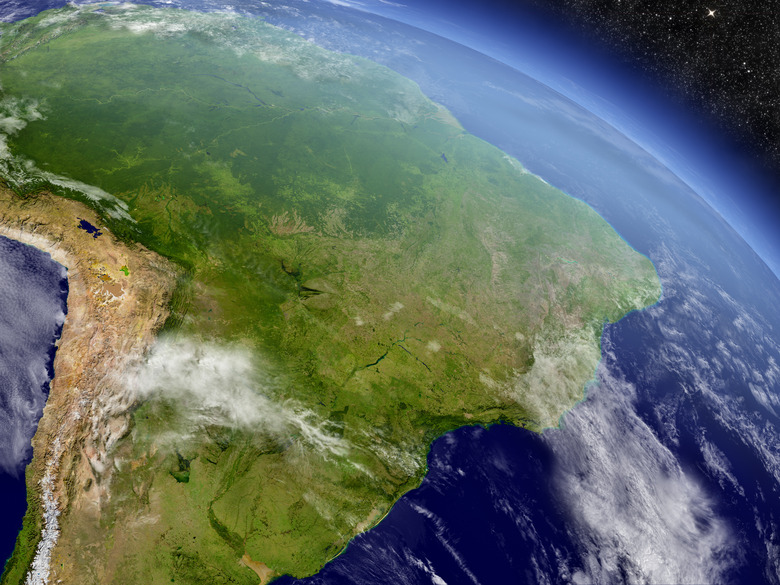The 8 Geographic Regions Of The World
Numerous schemes exist for dividing Earth's vast land area into helpful categories that combine geography with political considerations. While seven distinct continents exist, one of them, Antarctica, is uninhabited save for research stations and is not included in most formal regional schemes of the world.
The Unites States Department of Homeland Security (DHS) has divided the planet into eight distinct inhabited regions, listed and detailed below. Note that this is distinct from the G8, or group of eight industrialized nations recognized by the United Nations (UN). These eight geographic regions of the world provide a helpful analytical and practical framework for national defense, commerce and other geopolitical considerations.
Regions of the World
Regions of the World
The eight official DHS-recognized global regions on the world map are Africa, Asia, Europe and Oceania in the Eastern hemisphere and the Caribbean and the three American zones (North, Central and South) in the Western hemisphere. (A small portion of Europe is actually in the Western hemisphere.)
Most of the world's land lies north of the equator, i.e., in the Northern hemisphere. Of the eight specified regions, only Oceania lies entirely in the Southern hemisphere.
1. Africa
1. Africa
The second largest continent on Earth, Africa is about three times as large as the entire United States. It is connected to Asia via the Isthmus of Suez in Egypt, which lies adjacent to Israel. It features the longest river in the world, the Nile, as well as the venerated and massive Sahara Desert.
2. Asia
2. Asia
Asia is the planet's largest and most populous continent. As of 2020, Asia held the only two countries with a population of over 1 billion, China and India. Asia features the world's tallest mountain range (the Himalayas) and its tallest individual peak (Mount Everest). The Asia region holds more than 40 countries in all.
3. The Caribbean
3. The Caribbean
Despite its small size, the Caribbean was perhaps designated as its own region by DHS because of its proximity to the United States and the fact that it exists as a set of distinct island nations. Cuba, the Dominican Republic and Aruba are some of the tropical countries stretching from southeast of the U.S. proper toward northern South America.
4. Central America
4. Central America
As the name implies, Central America lies between North and South America, just north of the equator. It includes only seven countries (Belize, Costa Rica, El Salvador, Guatemala, Honduras, Nicaragua and Panama) but has been of significant geopolitical importance to the U.S. government thanks to immigration, narcotics and human-trafficking concerns.
5. Europe
5. Europe
Europe is about the size of the United States, yet most of its 44 countries are smaller than many of the larger individual U.S. states. The headquarters of the United Nations sit in Geneva, Switzerland.
Most European countries have access to the Atlantic Ocean or a major waterway, which was vital in the exploration of the world in centuries past.
6. North America
6. North America
The North America region includes the Unites States, Canada and Mexico as well as the massive island of Greenland. North America the continent also includes the DHS regions' Central America and the Caribbean. It includes grand mountain ranges, lush expansive soil and a range of climate-related and ecological variations.
7. Oceania
7. Oceania
Oceania is a unique region consisting of Australia, New Zealand and over a dozen island nations, most of them very tiny. Australia is famously known as "The Land Down Under" because it lies entirely in the Southern Hemisphere, but even the southernmost portions are fairly close to the equator, and the region is very temperate weather-wise.
8. South America
8. South America
South America has a distinctive pointed-triangle shape, tapering from north to south and featuring Brazil as its largest and most populous nation. The cities of Sao Paolo, Santiago, Caracas and Buenos Aires are world-revered cultural centers, and the 2016 Summer Olympic Games were held in Rio de Janeiro, Brazil.
Cite This Article
MLA
Beck, Kevin. "The 8 Geographic Regions Of The World" sciencing.com, https://www.sciencing.com/10-geographic-regions-world-8774247/. 28 January 2020.
APA
Beck, Kevin. (2020, January 28). The 8 Geographic Regions Of The World. sciencing.com. Retrieved from https://www.sciencing.com/10-geographic-regions-world-8774247/
Chicago
Beck, Kevin. The 8 Geographic Regions Of The World last modified March 24, 2022. https://www.sciencing.com/10-geographic-regions-world-8774247/
